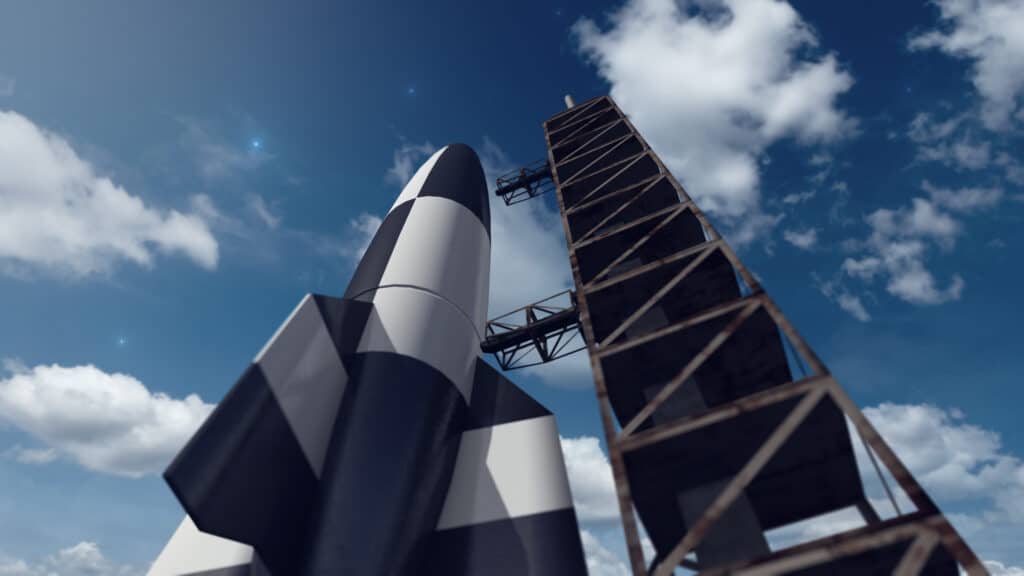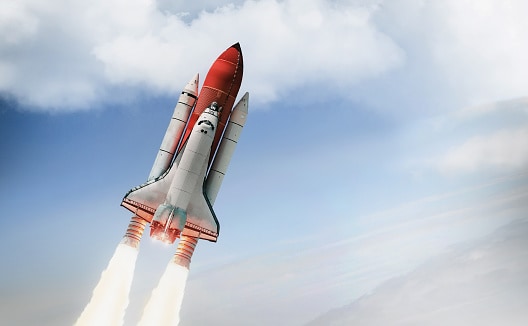The Mach number is the ratio between the speed of an object to the speed of sound. Scientists use this number to measure things that go very, very quickly. From planes to rockets, to a man skydiving from space, this number is an important figure for determining speed.
One important additional piece of information is that the Mach number only describes speed in a fluid medium. Thankfully, the Earth is full of fluid mediums. Water and air are the two most prominent mediums that scientists measure with the Mach number.
How to Calculate the Mach Number
Mach number is calculated by dividing the velocity of the object by the speed of sound in the fluid. The unit of the velocity can vary. A scientist could use feet per second or meters per second, for example. The important thing here is that the speed of sound calculation uses the same units. This simple division problem spits out the Mach number!

In this equation,
Marepresents the Mach number,
Vrepresents the velocity of the object, and
arepresents the speed of sound.
©A-Z-Animals.com/Em Thomas
How Fast Is Mach 1?
Using the equation we just established, it’s clear that Mach is a simple ratio between velocity and the speed of sound. So how fast is Mach 1? In other words, how fast does an object need to be moving in order to create a ratio of one?
To reach Mach 1, the velocity of the object’s speed needs to be the same as the speed of sound in the fluid that is being measured.

Rockets travel way faster than the speed of sound!
©iStock.com/:fredmantel
In water, the speed of sound is 1500 meters/sec. In air, the speed of sound is 340 meters/sec. With this in mind, an object needs to be traveling 1500 meters/sec through water in order to reach Mach 1, or 340 meters/sec in air to reach Mach 1.
That’s pretty fast!
How Fast Is Mach 6?
Now that we understand the basics of calculating the Mach number, we can start to explore various ratios. For example, how fast is Mach 6?
In order to get the ratio to equal six, the equation needs to read 6/1. That means the velocity of the object’s speed needs to be six times the speed of sound in the fluid.
If Mach 1 is fast, Mach 6 is really, really fast!
Let’s do an example using the numbers we established above. Let’s say we want to figure out the Mach number of an object moving through water. The speed of sound is 1500 meters/second in water. In order to get the Mach number to equal six, we need the ratio of the equation to be 6/1.
So if 1500 is serving in place of the “1” in the equation, the velocity of the object will need to be six times that number. In water, an object needs to move at a speed of 1500 x 6 meters per second to reach Mach 6. That means an object will move at 9000 meters/second.
What’s the Significance of Mach 6?
Mach 6 is significant because it qualifies as a high supersonic speed. To be moving 6x faster than the speed of sound is no small feat, and that puts Mach 6 in the category of hypersonic speed.
Hypersonic speed is met when an object exceeds Mach 5, or five times the speed of sound in a medium. You may have also heard of supersonic speed. Supersonic speed simply means the speed of the object surpasses Mach 1.
While Mach 6 doesn’t signify an entry into anything too specific, it is a unit of measurement that indicates an object is moving very, very quickly.

When something moves faster than Mach 5, it becomes supersonic.
©dima_zel/iStock via Getty Images
Though a bit off-topic, you may have encountered Mach 6 in relation to the film Speed Racer. In this movie, Mach 6 is the name of a top-of-the-line racing car. Mach Six is also the name of the 2003 album by the band MC Solaar.
What Units of Measurement Are Used?
Meters and seconds are pretty small units for measuring objects moving this fast. It’s common to see scientists use miles per hour to calculate this number.
The speed of sound in miles per hour in air is 767 mph. In water, the speed of sound is 3,345 mph. With that in mind, Mach 1 in air is met when an object is moving 767 miles per hour. Mach 6 is met when that object is moving 4,602 mph!
Again, it is the scientists’ choice of what unit to use for their measurement. They may make this choice based on the distance the object is traveling or how quickly it’s moving. A number of factors go into the decision. The important part of the Mach calculation, however, is that the same unit is used for the velocity of the object as is used for the speed of sound.
How Many Mach Numbers Are There?
Because the Mach number is simply a ratio, the potential for Mach numbers is hypothetically limitless.
In reality, objects haven’t flown much quicker than Mach 32. It would be pretty intense for an object to fly a triple-digit Mach number. For example, a Mach 100 speed would need to be 100 times the speed of sound. That’s unfathomably fast!
Mach Number Records
Learning about the Mach number opens the door to some pretty exciting questions about physics, space, and speed. Here are some basic answers!
What’s the highest Mach number a jet-powered aircraft has ever gone?
A NASA rocket presently holds the record for the highest Mach number ever achieved. That rocket moved at a speed of around Mach 9.6. That means the rocket flew through the air at almost 7,000 mph. To put that in perspective, the average commercial plane flies between 500-600 mph. That means that the rocket flew around 14 times quicker than the typical plane!

Planes don’t even reach Mach 1.
©muratart/Shutterstock.com
This rocket, the X-43A scramjet, won the Guinness record for highest Mach number in November of 2004. It first earned the record in March of the same year but was only traveling at Mach 6.8. The scientists working on the project drastically increased the speed at which the rocket flew in less than a year!
What’s the highest Mach number a human has reached?
The current record-holder for the highest Mach number ever reached by a human is the Apollo 10 spacecraft, which reached approximately Mach 32. This spacecraft traveled at a speed of 24,791 miles per hour, which is almost unimaginably fast.
There were three men on this 1969 mission: Thomas Stafford, Gene Cernan, and John Young. This mission led to the second-ever orbit of the Moon.
What’s the world record for supersonic freefall?
The world record for supersonic freefall was reached when Felix Baumgartner executed a skydive from space. He reached a speed of 843.6 mph in his plummet, meaning he moved faster than the speed of sound.

Felix Baumgartner jumped from 39, 045 meters high!
©digitalmazdoor digitalmazdoor/iStock via Getty Images
History of The Mach Number
Jacob Ackeret established the Mach number in 1929. He was a Swiss engineer who devoted a lot of his life to studying aerodynamics. He was a scientist and professor, and the designation of the Mach number emerged when he was studying supersonic foil.
You’ll observe that Jacob Ackeret didn’t name this number after himself. Instead, the number was named after the physicist Ernst Mach. In 1887, Mach was experimenting with photographing an object that was traveling faster than the speed of sound (or, as we now would say, at a speed greater than Mach 1).
Jacob Ackeret attributed his findings regarding the Mach number to Ernst Mach due to Mach’s prior contributions to the understanding of speed.
Conclusion
As you now know, calculating the Mach number is a lot simpler than it seems! With a simple ratio of the velocity of an object over the speed of sound, scientists can use this number to articulate very fast speeds.
Planes, rockets, and even skydivers have been measured using the Mach number. It’s a great way to conceptualize speed in relation to one of the quickest things in our daily lives: sound. The Mach number is an important contribution to physics.
Thank you for reading! Have some feedback for us? Contact the AZ Animals editorial team.








